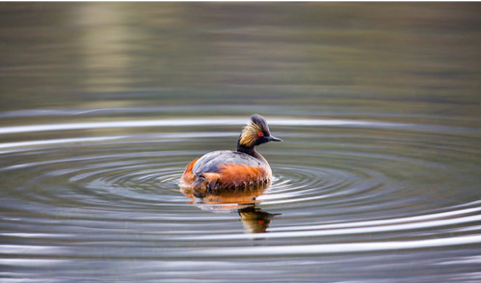By Mary VanFleet
Grebes are a fun family of birds to watch at Henrys Lake. They are constantly chattering in the bays, even before the ice is off. You can’t see them but they are making a lot of noise!
One of the smaller species of grebes frequently seen at Henry’s all summer is the Eared Grebe. Note the red eye and the flashy look with the golden fan behind the eye. Beautiful little birds. They love open water and can be seen while you are out boating or float tubing around the lake. They are busy little birds, scurrying about and chattering all the way.
Their chicks are bright orange fuzz balls so watch out for them, perhaps riding on their parent’s backs. Just before hatching their chicks, the adults tending the eggs are hearing peeping sounds from the eggs. Parents know they need to prepare for chicks by turning the eggs more often, making more room in the nest, spending more time incubating, and bringing food to the nest. Chicks, once hatched ride on the backs of parents for a week or so, then parents part ways, each taking half the brood.
As a diving bird, all grebes have legs placed further back in the body, great for diving, not so much for walking on the ground. This forces them to take off from the water by running on the surface to take off. Note the sharp beaks of a diving bird vs. the flatbill of a duck. This tells you ducks eat vegetation, and diving birds eat little crustaceans and other small creatures. Diving birds have some ability to control their buoyancy by compression of feathers and exhaling air from their air sacs that provide their ability to float. This allows them to dive deeper for food.

In September, Eared Grebes make a nonstop flight of hundreds of miles to winter or summer habitats. This is an interesting journey. Almost all Eared Grebes in the US migrate to two places: Great Salt Lake and Mono Lake in the Eastern Sierras in California. There they feed on millions of brine shrimp. They actually transfer their bodily functions to put energy into digestion and weight gain and sacrifice flight muscles in the process. They will eat until they double their weight and store enough fat to make the remainder of their migration journey. At this point, their flight muscles are so depleted they cannot fly. The brine shrimp supply is used up.
Now the bodily functions again shift, knowing their need to grow strength and mass in the flight muscles, and shrinking digestive processes to shift energy to muscle building. Now they are unable to eat. It’s now October, and hopefully, enough stored fat has been converted into muscle. At once, they all take off together for another nonstop leg of their flight to the Pacific Ocean, where they spend the winter. A similar process occurs in spring for the long journey north for suitable summer habitats to raise their chicks.
